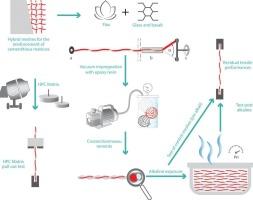增强胶凝复合材料用耐碱亚麻基网的初步评价
IF 9.2
2区 工程技术
Q1 ENERGY & FUELS
引用次数: 0
摘要
与钢筋加固的传统混凝土相比,纺织增强混凝土(TRC)的生产需要更少的材料和能源,这为水泥和混凝土工业部门到2050年应达到的净零混凝土生产提供了一些解决方案。为了更进一步,本研究探讨了亚麻基网格作为胶凝材料中增强网格的基本组成部分的发展。亚麻线和混合线(亚麻线和玻璃或玄武岩粗纱的组合)用环氧树脂浸渍形成网。评估了亚麻基网的物理力学性能,并评估了这些增强材料的耐碱性,以确定它们在胶凝基质中的耐久性。在等重增强条件下,亚麻基网格在比模量和比强度方面表现出比混合网格最好的性能。来自对照批次的混合网格显示出相同范围内的特定性能,无论它们是由ar玻璃还是玄武岩组成的。然而,在所有增强网中,耐碱玻璃粗纱的使用使混合网受碱性环境的影响较小,从而大大减轻了混合网力学性能的退化。相比之下,玄武岩混合网在暴露于碱性环境后,由于玄武岩纤维的腐蚀,其抗拉强度和应变会大幅降低。拉出测试揭示了在高性能混凝土基体中嵌入的亚麻基网格的最大粘结强度。本文章由计算机程序翻译,如有差异,请以英文原文为准。

Preliminary assessment of alkali-resistant flax based meshes for reinforcing cementitious composites
The production of textile-reinforced concrete (TRC) requires less materials and energy in comparison with conventional concrete reinforced with steel rebars, which draws some solutions towards the production of net zero concrete that the Cement and Concrete Industry sector should reach by 2050. To go one step further, this study investigates the development of flax based meshes as basic components for a reinforcement grid in cementitious materials. Flax strands and hybrid strands (combination of flax strands and glass or basalt rovings) were impregnated with an epoxy resin to form meshes. The physical and mechanical properties of the flax based meshes were assessed and the alkaline resistance of these reinforcing materials was evaluated to determine their durability in a cementitious matrix. At isoweight of reinforcement, the flax-based meshes demonstrated the best performance in terms of specific modulus and specific strength compared to the hybrid meshes. The hybrid meshes from the control batch displayed specific properties in the same range, whether they were constituted of AR-glass or basalt. However, the use of alkali-resistant glass rovings strongly mitigated the degradation of the mechanical properties of the hybrids meshes by making them less affected by the alkaline environment, among all the reinforcement meshes. In contrast, hybrid meshes with basalt experienced an extensive reduction in tensile strength and strain after exposure to alkaline environment, due to the corrosion of the basalt fibres. Pull-out tests revealed maximum bond strengths for the flax based meshes embedded in a high-performance concrete matrix.
求助全文
通过发布文献求助,成功后即可免费获取论文全文。
去求助
来源期刊

Sustainable Materials and Technologies
Energy-Renewable Energy, Sustainability and the Environment
CiteScore
13.40
自引率
4.20%
发文量
158
审稿时长
45 days
期刊介绍:
Sustainable Materials and Technologies (SM&T), an international, cross-disciplinary, fully open access journal published by Elsevier, focuses on original full-length research articles and reviews. It covers applied or fundamental science of nano-, micro-, meso-, and macro-scale aspects of materials and technologies for sustainable development. SM&T gives special attention to contributions that bridge the knowledge gap between materials and system designs.
 求助内容:
求助内容: 应助结果提醒方式:
应助结果提醒方式:


